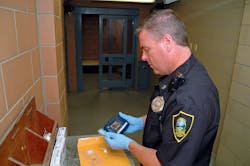It was just another sunny afternoon in the cruiser until you found yourself investigating a woman who is literally clawing at her own skin. On the ground you note a container with a white substsance has fallen from her bag. Based on what you know, is this woman high on PCP? You notice she’s exhibiting rapid eye movement and think twice about whether and how to approach. Could it be she’s OD’d on meth? Maybe it’s neither.
Bath salts have been on doctors’ and law enforcement’s radar for the past few years, but seem to be picking up pace. (Read LET’s August 2011 Drug Watch: Bath Salt Ban by Editor Tabatha Wethal for more facts pertaining to the drug.) Some say bath salts are similar to PCP with its volatile, violent symptoms. Unfortunately this drug (chemically, at least) is not that simple.
A slippery substance
While lawmakers are hard at work banning the salts, it’s not an easy job. Instead states are tackling the problem one ingredient at a time, whack-a-mole-style, chasing down new recipes and chemicals as quickly as they pop up. Today anyone can go into a head shop and purchase Ivory Wave, Red Dove or Blue Silk. Since its recipe is always changing, users’ symptoms will often depend on which “cocktail” of chemicals they obtained—a big reason why bath salts are so deadly.
“There’s very little that we actually know about how they interact on the brain,” says John Johnson, director of law enforcement programs at Thermo Scientific Portable Analytic instruments. Johnson uses his background in biochemistry to build the right technology for specific applications in the field.
“What we do know,” says Johnson, “is mephadrone has been available in the UK for the many years, and seems to be the one the most likely of causing an overdose.” He describes bath salts as “a combination of the worst of all drugs put together.” It’s difficult, then, for officers on the street to recognize someone using this substance specifically.
Street science
Agencies might not know they have a bath salt problem in their community simply because they can’t make these identifications. But now there’s a machine that does just that. Thermal Fisher Scientific, Inc.—the hazmat and bomb squad folks—recently launched TruNarc as their first foray into narcotic testing. TruNarc is a handheld laboratory analyzer that accurately tests liquid and solid samples for common narcotics like cocaine, methamphetamine, MDMA and pharmaceuticals. The device uses Raman spectroscopy to develop a molecular fingerprint unique to each individual chemical. Spectroscopy has always been available in the lab setting, but now it’s literally on the street delivering easy-to-read results in seconds.
The device can identify the MDPV (common in most bath salts), as well as numerous other chemicals in the mix. This is important, because not only can law enforcement search for and find these active ingredients in the field rather than sending the whole shebang to the lab, but they can also detect trends in over-the-counter drugs and keep a watchful eye on emerging ‘ingredient’ make-up. Even though the DEA recently added three bath salt substances to their list, TruNarc’s currently got nine (not-yet-illegal) identified bath salts in its capabilities.
Test-ingestion not required
Once a sample is selected TruNarc generates a report and lists each chemical by name. Johnson says it’s common now to see bath salts being mixed with things like Advil PM, methamphetamine and ecstasy.
“Officers can then take that information and color-code it … Something that’s on the controlled substances list shows up as a red screen; something that’s maybe not on the controlled substances list but should be a concern shows up as green screen with a chemical name itself,” says Johnson. When a sample comes back showing a mixture of a bath salt that’s 95 percent MPDV, it will read “MPDV”. But if the mix includes methadrone and proverilone it will indicate the combination.
“First and foremost, what we like about it, is it is safe.” Detective Brian Coen of the Quincy (Massachusetts) Police Department Drug Control Unit has been privy to TruNarc for eighteen months of beta testing before its official launch in February of this year. “With this device we don’t have to be exposed to most substances.”
There’s nothing like having a bag of white powder thrown at you while a fellow officer asks, “What’s this?” With TruNarc there’s no need to wonder what sorts of particles are hitchhiking their way home to the family.
Report results are time and date stamped and saved on the system. At the end of the shift officers can download the data onto a software program and print off reports. Documentation like this is a boon to both law enforcement and experts in court.
Say goodbye to the middle men
No more the days of handling a sample, schlepping it to the lab and awaiting results. Imagine a bust-buy operation where you can very quickly identify what a substance is. Cocaine? Bath salt? Benzacane? Knowing this you save weeks (if not months) tangled up in an investigation.
“It’s a pretty exciting time to be using a device like this,” says Coen. The community of Quincy has particular struggles with opium addiction—namely oxycodone—which often leads to heroin addiction. Since his department has been using TruNarc (they have three), Coen says they’ve had zero false positives.
The product and its possibilities hits close to home for Coen. In 2009’s Melendez-Diaz vs. Massachusetts case the US Supreme Court ruled it a violation of the Sixth Amendment for a prosecutor to submit a chemical drug test report without the testimony of a person who physically performed the test. Coen hopes TruNarc’s Raman Spectroscopy technology can help nudge them over that hurdle.
“I know I’m putting the cart before the horse, but we’re hoping for a confirmatory down the road; I really believe that this has the potential to get us there.” ¦

Sara Scullin
Sara Scullin was the Editor of Law Enforcement Technology magazine, a monthly business-to-business publication that covers technology trends and best practices for public safety managers. LET is part of SouthComm Law Enforcement Media, which also publishes Law Enforcement Product News and Officer.com. Sara had covered the law enforcement industry since March 2008.



